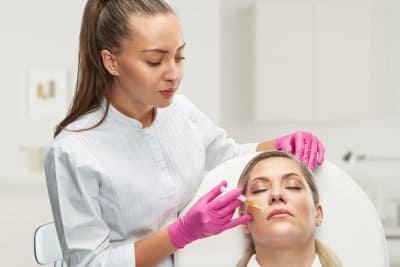What is Platelet Rich Plasma (PRP)?

Your blood is essentially made up of four main components: red blood cells, white blood cells, plasma, and platelets. Platelets are the cells in the blood that help tissue to heal and grow new cells. PRP is a natural product that is created from your own blood. Your blood is taken and spun in a centrifuge, which enables the separation of red and white blood cells from plasma and platelets (clear fluid). This plasma now contains a higher-than-normal number of platelets and is called Platelet Rich Plasma (PRP).
PRP Procedure
Depending on how many areas you want to be treated, a volume of blood will be taken. This is usually between 10 to 30 ml. PRP treats two main concerns; acne scars and hair loss. Acne Scars (also known as the Vampire Face Lift): Upon arrival to your appointment, blood will be drawn from your arm and placed in a centrifuge. After it is spun and separated, the PRP is injected into the acne scar areas. The PRP promotes wound healing and regenerates the growth of collagen and elastin in the area it is injected. Hair Loss: PRP can also be successfully used to treat thinning hair and hair loss, particularly male pattern baldness. Just as with acne scar treatment, blood is drawn from your arm and placed in a centrifuge. After it is spun and separated, the PRP is injected directly into the scalp at the level of the hair follicles. Injections are made approximately at every half inch over the area of thinning hair. The PRP helps stimulate the activity of the hair follicles and promote new hair growth. It is recommended that patients receive three treatments at four to six-week intervals.
PRP Considerations

Am I a Candidate for PRP Treatment?
Your doctor can help determine if PRP treatment is right for you but generally good candidates are:
- Healthy individuals who do not have a life-threatening illness or medical conditions that can impair healing
- Non-smokers and non-drug users
- Individuals with a positive outlook and realistic goals in mind
- Individuals that are bothered by their acne scars
- Individuals that are bothered by their hair thinness
Treatment Risks

Each year thousands of individuals undergo successful PRP treatment, experience no major problems, and are happy with the results. Significant complications from PRP treatment are extremely rare. However, make sure that you understand what treatment involves, including possible risks and follow-up care. PRP treatment poses a few minor risks, including minimal pain, swelling, bruising, redness, or heat like any major procedure, PRP treatment poses a risk of bleeding and infection. It’s also possible to have an allergic reaction to materials used during or after the procedure. You can help minimize these risks by following the advice and instructions of your doctor, both before and after your procedure. If you have any concerns about the risks involved, please consult your doctor.
Results and Recovery

Results and improvement in both acne scars and hair loss can be seen in as little as one to two weeks and will continue to improve for four to six months following your treatments. The first thing people will notice is an improvement in skin turgor and elasticity. Collagen and follicle production can take up to three months to occur and can differ depending on the individual. There is no downtime associated with PRP treatment. The treatment itself usually lasts half an hour, and you are able to continue with your normal daily activities immediately. Ask your doctor for more information about your individual results and recovery.
RegenLab PRP & CELL THERAPY SPECIALISTS
WHAT IS A-PRP® / PRP™?
A-PRP®/PRP™ is prepared from a small sample of the patient’s own blood using the RegenKit®technology. Only five minutes are needed to spin the sample in the Regen™ centrifuge and separate plasma and platelet sediment from the remaining cellular composition. By using the patient’s own blood to prepare the platelet concentrate, the RegenKit® technology vastly reduces the risk of an adverse or allergic reaction. AUTOLOGOUS PLATELET RICH PLASMA BIOLOGY A-PRP® COMPONENTS Platelets are key factors in hard and soft tissue repair mechanisms. They provide the essential growth factors FGF, PDGF, TGF-ß, EGF, VEGF, and IGF that are involved in stem cell migration, differentiation, and proliferation. The stimulation of fibroblasts and endothelial cells induces new extracellular matrix deposition and neo-vascularization. Plasma is essential for cell survival as it contains nutrients, vitamins, hormones, electrolytes, and proteins. Proteins are key molecules for the coagulation process and the formation of the fibrin polymer that will serve as a scaffold for cell migration, differentiation, and proliferation.
THERAPEUTIC PLATELET CONCENTRATION
The Regen™ BCT (Blood Cell Therapy) tube prepares 5 to 6 ml of autologous platelet-rich plasma with a platelet recovery greater than 80% and a concentration factor of 1.6-fold. Although the system is technically capable of producing significantly higher platelet concentrations, it is not what research shows to be beneficial for clinical use. More and more studies demonstrate that concentrations of platelets 1 to 3 times over the baseline show more robust healing rates than those with concentrations of 3 to 8 times the baseline1. Some studies even showed that too high platelet concentrations may actually have negative effects. In an, in vivo study2 it was shown that highly concentrated platelet preparations had an inhibitory influence on osteoblast activity, probably due to unwanted inhibitory and cytotoxic effects of growth factors at such high concentrations. Similarly, an in vitro study3 demonstrated that platelet concentration over 2.5-fold resulted in a reduction in proliferation and a suboptimal effect on osteoblast function.
WHITE BLOOD CELLS IN TISSUE REGENERATION
White blood cells are strongly reduced (> 85% depletion) with the Regen™ PRP® system. The role of white blood cells (WBC) in healing is controversially discussed among physicians. To address this concern scientifically, WBC subsets, granulocytes, and mononuclear cells need to be looked at individually. Granulocytes, and more specifically neutrophils, are the front-line defenders against invading pathogens and are associated with the inflammatory response. They release a large variety of highly active antimicrobial substances and proteases. Uncontrolled release of these factors can cause severe damage to the tissue, delay healing rates and increase the risk of scarring4. Thanks to the Regen™ PRP®system, more than 96% of the granulocytes are removed from autologous platelet-rich plasma. The few white blood cells still present in autologous platelet-rich plasma are mostly mononuclear cells(lymphocytes and monocytes). These two cell types are also involved in the immune response but have also been shown to support the healing process5,6. REFERENCES: 1- Rappl LM et al. Effect of platelet-rich plasma gel in a physiologically relevant platelet concentration on wounds in persons with spinal cord injury. Int Wound J 2011; 8:18.7–195. 2- Weibrich G. et al., Effect of platelet concentration in platelet-rich plasma on peri-implant bone regeneration. Bone 2004; 34:665-671. 3- Graziani F. et al., The in vitro effect of different PRP concentrations on osteoblasts and fibroblasts. Clin. Oral. Impl. Res. 17, 2006; 212–219. 4- Brubaker A.L. et al. Neutrophils and natural killer T cells as negative regulators of wound healing. Expert Rev. Dermatol. 2011; 6(1). 5-8 5- Barbul, A.et al. Wound healing in nude mice: a study on the regulatory role of lymphocytes in fibroplasia. Surgery 1989;105(6): 764-769. 6- Brancato S.K. and Albina J. E. Wound Macrophages as Key Regulators of Repair. Am J Pathol 2011, Vol. 178, No. 1, 19-25.
REGENLAB
RegenLab® A-PRP® technology SWISS R&D AND MANUFACTURER IN BIOTECHNOLOGY
RegenLab® is recognized as a leading provider of patented technology to produce autologous platelet-rich plasma. The technology processes the patient’s own blood and isolates concentrated platelets and proteins for indications in various medical disciplines. The RegenKit®-BCT and RegenKit®-BCT Plus product families are indicated by the U.S. FDA for the safe and rapid preparation of autologous platelet-rich plasma from a small sample of blood at the patient’s point of care. The platelet-rich plasma is mixed with autograft and/or allograft bone prior to application to a bony defect for improved handling characteristics. The RegenKit®-BCT and RegenKit®-BCT Plus product families are for single use only.
Sources:
https://doctorspodiatrist.com/prpplatelet-rich-plasma
https://www.drdoctora.com/procedures/platelet-rich-fibrin/
https://www.kalamazooxraysales.com/product/regenlab-prp-technology




